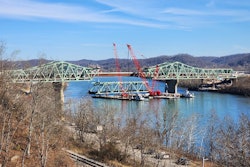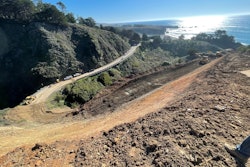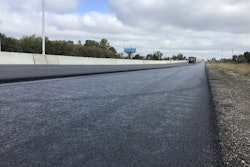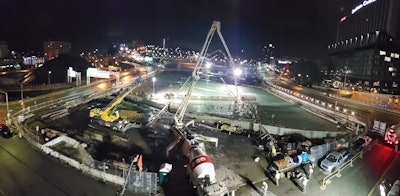
A park built over an interstate and three innovative bridge projects were recently named winners of the 2023 PCI Design Awards by the Precast/Prestressed Concrete Institute.
The 60th annual awards recognize creative and innovative uses of precast concrete and are judged by a panel of engineers, architects and precast concrete producers. Judges consider such criteria as aesthetics and structural durability, among others.
Park built over interstate
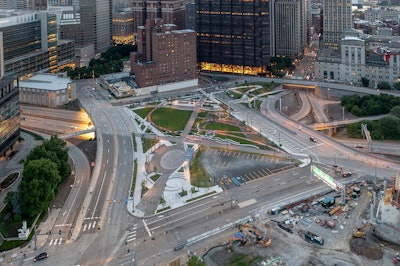 Pennsylvania's first park built over an interstate is in Pittsburgh over I-579.City of Pittsburgh
Pennsylvania's first park built over an interstate is in Pittsburgh over I-579.City of Pittsburgh
The $30 million project created a .3-acre green space over I-579 in the historic Hill District with art installations, story walls, outdoor classroom space, an amphitheater and bike and pedestrian paths.
The project consisted of 126 precast adjacent box beams, each weighing 140,000 pounds, for the superstructure that had to be strong enough to hold the park, which included adding soil up to 5 feet deep. An 8-inch-thick cast-in-place concrete deck slab was placed on the beams. The deck contained two layers of reinforcement steel in each direction.
Precast concrete beams also support hanging lighting for the vehicle tunnel below.
“Of all the challenges this project faced, developing a viable structural solution for the bridge was the greatest hurdle. The new bridge had to ‘fill the gap’ between the two existing vehicular bridges, while maintaining the required vertical clearance above the interstate and carrying sufficient soil depth to sustain plantings on the surface,” says Nicholas Burdette, PE, Northeast Region bridge lead, HDR.
HDR was the engineer of record; Fay, S&B USA Construction was the general contractor.
The project has also won a 2023 Outstanding Civil Engineering Achievement Award from the American Society of Civil Engineers.
Using NEXT “D” beams
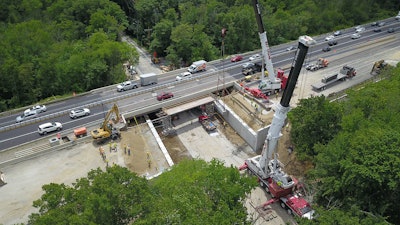 One of eight bridges replaced in eight weekends on the Massachusetts Turnpike.Massachusetts DOT
One of eight bridges replaced in eight weekends on the Massachusetts Turnpike.Massachusetts DOT
The NEXT beams were used instead of prefabricated bridge units composed of steel beams with a precast concrete deck. The NEXT D beams provided a more efficient cross-section design and were used with precast concrete approach slabs and abutment caps.
In the months ahead of the weekend bridge replacements, cast-in-place concrete micropile foundations, abutment stems and wing walls were constructed and backfilled under the existing approach spans. During the 55-hour weekend traffic diversions, demolition and precast concrete erection occurred.
“Each weekend project required 60 precast concrete pieces for the accelerated bridge construction,” according to PCI. “Some of the precast concrete pieces weighed more than 60,000 pounds, so a heavy crane was required to hoist them into place.”
The NEXT D beams will also reduce maintenance costs by eliminating the need to repaint steel beams.
Gill Engineering Associates was the engineer of record; J.F. White Contracting was the general contractor.
Historic-bridge rehab
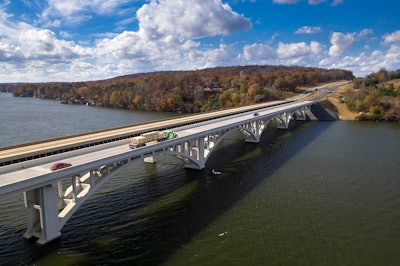 The widened 95-year-old Swift Island Arch Bridge in North Carolina.N.C. Department of Transportation
The widened 95-year-old Swift Island Arch Bridge in North Carolina.N.C. Department of Transportation
The $16 million project at Lake Tillery involved widening and upgrading the bridge, which had been closed in 2003 due to structural deterioration and weight restrictions. After public outcry, NCDOT scrapped plans to replace the bridge and convert it to a bike and walking path. Instead, it preserved the piers and arches while replacing and widening the superstructure, using precast concrete girders, deck slabs and fascia panels that replicated the original design.
“To preserve the existing arches and piers without overstressing them, precast concrete added redundancy to the structural system and reduced bending moments in the original members in order to carry vehicular loads in a safe manner,” says John Sloan, North Carolina bridge program manager for AECOM, which was the engineer of record.
Before adding the precast concrete, the old bridge was taken apart down to its arches to retain its architectural character and so it could be rebuilt with a wider deck. The process involved creating a four-dimensional model to predict structure demands throughout construction to prevent overstress.
“Not only did we save the Department of Transportation considerable cost and accelerate the completion of construction, but we also preserved the history of this structure,” says Kevin Fischer, NCDOT assistant state structures engineer, field operations.
PCL of Denver, Colorado, was the general contractor.
Quick replacement of National Park bridge
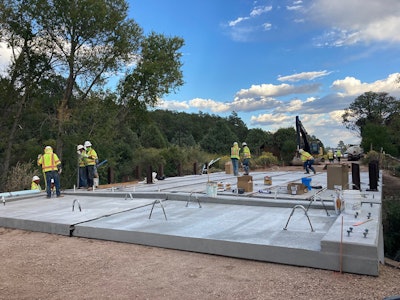 Precast concrete was used to replace the deteriorated bridge over Glorieta Creek on New Mexico Route 50.New Mexico DOT
Precast concrete was used to replace the deteriorated bridge over Glorieta Creek on New Mexico Route 50.New Mexico DOT
Closing the bridge meant an 18-mile detour for residents. The National Park Service was also concerned that work would disturb plants and wildlife; it also wanted to preserve its historic setting in the Pecos National Historical Park where the Civil War Battle of Glorieta Pass occurred.
“Given its ability to be quickly prefabricated off site and stored until needed, precast concrete was the best solution,” says Richard C. Castillo, president and CEO of Castillo Prestress, which produced the precast concrete for the $2.2 million project.
The New Mexico Department of Transportation was able to reduce road closure to seven weeks through an accelerated bridge construction process. All construction had to be conducted from a 60-foot right of way to protect the environment.
The 1923 bridge was cut apart and lifted out from above to protect the stream and wetlands downstream. Existing abutments were left to preserve the flow characteristics of the creek, to preserve the existing aesthetics of the site and to protect the new substructure. There was no staging area, so the precast concrete abutment caps, wing walls, slab beams and approach slabs were delivered on a just-in-time schedule. Haulers had to drive in reverse for the last mile approaching the site because there was no room to turn around.
Ultra-high-performance concrete was used in the joints to further resist the deterioration of the deck.
AUI Inc. was the general contractor.


